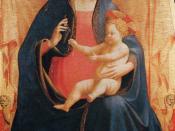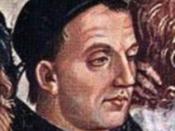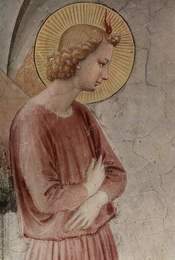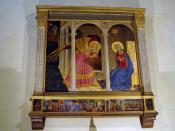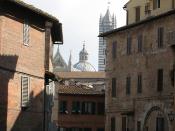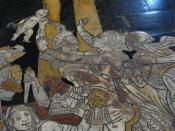Simone Martini was an Italian Painter. He was born in Siena in the year of 1284. He played a great role in the development of the International Gothic style. His brother-in-law was Lippo Memmi, an artist, who he influenced. One of his most renowned pieces of work was the Maesta of 1315. Maesta means the ÃÂVirgin and Child in MajestyÃÂ. This picture depicts how art, war, politics, and miracles mix. His art is noted for being styled, soft decorative, and elegant. He painted an altar-piece for the church of St Catherine at Pisa in the year 1320, which has now been taken apart. The larger part is in the Academy at Pisa, two other parts are in other buildings in the same city. Simone passed his later years at Avignon working for the papal court then lived there. While dwelling there, he decorated many sections of the cathedral and numerous rooms and chapels in the papal palace.
Some say that he made a portrait of himself at Avignon of Petrarch. In Avignon he met Petrarch. There was where he painted the famous portrait, Madonna Laura. He died on August 4th 1344. The record does not clearly tell if he died in Siena or if his body was transported there on that day. There are many of SimoneÃÂs works in the place where he was born. One of his works is at a museum in Altenburg. He also has at least three private works here in the U.S.A. In 1867 the portrait of Petrarch, credited to him, was sold in at the Poniatowski sale. During that same time and same sale a portrait of Laura was also sold, which was unquestionably his art work.
Fra Angelico was born in 1395 in Tuscany. He was an Early Italian Renaissance painter. Fra Angelico was his most popular name but he also had other names such as Guido di Pietro, Fra Giovanni da Fiesole, and Beato (the blessed) for his talent in painting religious themes. He was one of the monks who moved to the monastery of San Marco in Florence in 1436. This move was an impactful decision, which put him in the hub of artistic movement of the area. Vasari accounts that at Cosimo's persuasion that Fra Angelico was given the duty of elaborating the monastery, including the marvelous Chapter House fresco, the frequently copied Annunciation at the peak of the stairs, the Maesta with Saints and the various smaller frescoes illustrating phases of ChristÃÂs life that decorate the walls of each individual chamber. He finished one of his most well known works in 1439. This was the Altarpiece for St. Marco's, Florence. The outcome was remarkable for that time period. Imagery of the Madonna and Child encircled by saints were widespread, but they frequently represented scenery that was evidently heavenly. Saints and angels floated over instead of people. In this case the saints stood directly within the area, assembled in an ordinary, making it look like they were just able to talk about it. Sacred Conversations was the name given to this painting. This type of painting was a great influence on painters such as Giovanni Bellini, Perugino and Raphael. Fra influenced one of the greatest artists of all time, Michelangelo. When he was asked by Pope Julius II to adorn the robes of the Apostles in the luxurious manner, he answered that they were poor men. Inside the chambers of SanÃÂMarco, Fra Angelico had proven painting talent. The artistÃÂs individual versions were enough to make unforgettable pieces of art. In the use of the plain fresco method, the vivid pastel colors, the set up of some important figures and the talented use of expression, body language and motion, Michelangelo demonstrated that he was the artistic successor of Fra Angelico. Fra Angelico died on February 18th 1455.
Bibliography-Diana Norman. Siena and the Virgin: art and Politics in a Late Medieval City State. Yale University Press, 1999.
-Frederick Hartt, A History of Italian Renaissance Art, (1970) Thames & Hudson,-http://en.wikipedia.org/wiki/Gothic_art
